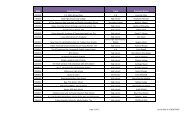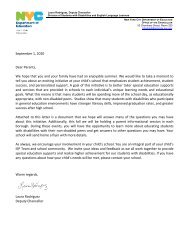Predicting language outcome in infants with autism and pervasive ...
Predicting language outcome in infants with autism and pervasive ...
Predicting language outcome in infants with autism and pervasive ...
Create successful ePaper yourself
Turn your PDF publications into a flip-book with our unique Google optimized e-Paper software.
<strong>Predict<strong>in</strong>g</strong> <strong>language</strong> <strong>outcome</strong> <strong>in</strong> <strong>in</strong>fants <strong>with</strong> <strong>autism</strong> 271Figure 1b.Performance on jo<strong>in</strong>t attention at 20 months by diagnosis.functional or pretend play (score=0, n=4) was taken as low play ability <strong>and</strong>production of either functional or pretend play acts (score=1 or2,n=14) wastaken as high play ability. For the jo<strong>in</strong>t attention measure, gaze switch<strong>in</strong>g on 67%or more trials (n=8) was taken as high jo<strong>in</strong>t attention ability <strong>and</strong> gaze switch<strong>in</strong>gon 50% or fewer trials (n=10) as low jo<strong>in</strong>t attention ability. For the goal detectiontask, looks to adult on 25% or more trials (n=9) was taken as high goal detectionability <strong>and</strong> looks to adult on 25% or fewer trials (n=9) as low goal detection ability.For the imitation task, imitat<strong>in</strong>g on 50% or more trials (n=10) was taken as highimitation ability, <strong>and</strong> imitat<strong>in</strong>g on 25% or fewer trails (n=8) as low imitation ability.The group was also divided on the basis of ‘high’ <strong>and</strong> ‘low’ NVIQ at 20 months(low NVIQ=less than 85, n=9; high NVIQ=85 or greater, n=9).Differences between the <strong>autism</strong> <strong>and</strong> PDD participants were compared us<strong>in</strong>gFisher exact comparisons of high versus low performance on each experimentalmeasure <strong>and</strong> NVIQ. There was a non-significant trend ( p=0.08) for the participants<strong>with</strong> PDD to outperform the participants <strong>with</strong> <strong>autism</strong> on the measure of play,reflect<strong>in</strong>g the fact that all four participants who produced no functional or pretendplay had <strong>autism</strong> <strong>and</strong> both participants who produced pretend play had PDD. Theparticipants <strong>with</strong> PDD outperformed the participants <strong>with</strong> <strong>autism</strong> on the jo<strong>in</strong>tattention measure ( p




